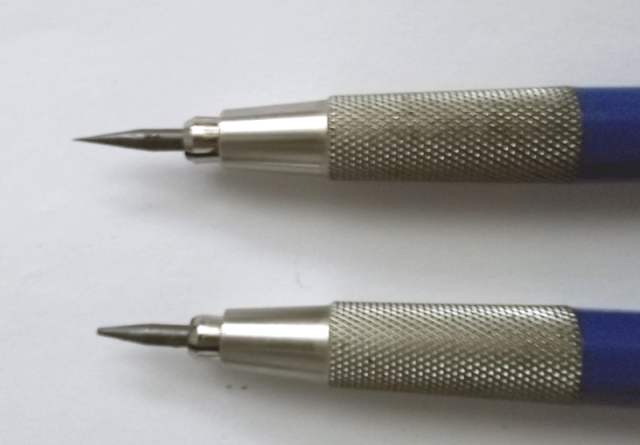Graphite leads used in lead holders need to be sharpened from time to time. There are several ways to do it and some techniques to use.
Unsharpened graphite lead
Sharpened graphite lead
The one i most use is the rotary sharpener made for this kind of leads, Some lead holders also include a top button sharpener that can be used to sharpen the lead, also a sand paper block or even a piece of sand paper can be used to sharpen the lead to give it a desire shape, a sharp knife can as well be used to sharpen the graphite lead. I also have seen some kind of little traditional pencil sharpeners adapted for the size of the lead, but never try anyone.
Rotary Sharpener
The rotary sharpener is made of a cylinder
and has 2 holes with different lengths to measure the size of the lead to be sharpened, a
cotton cylinder to clean up the lead after sharpening and a main hole
where the lead holder with the lead is placed to be sharpened.
The 2 Holes define 2 different lengths for the lead, A big one for drawing and a littler one for writing and other softer activities.
So in order to sharpen a graphite lead with this rotary sharpener you would first select a lead length, then release enough lead on the lead holder and insert the lead in the chosen hole, so the lead reaches the bottom of the hole, then release the holder and let it move in direction of the sharpener surface.
Two sizes of graphite lead to be sharpened
After a size have been selected and the lead holds the correct length as shown in the above picture, insert the lead holder in the upper big hole and while holding the sharpener with one hand and the lead holder with the other hand, start rotating the lead holder around the sharpener until no resistance is sensed. You must be careful, when rotating the lead holder not to apply too much force, or the lead can break, this is more noticeable in the softer/blacker degrees of graphite (B to 6B).
Two different lead tips: for drawing (top) and for writing (bottom)
Replacing the Cotton Cylinder
One of the things i first thought the first time i saw my rotary
sharpener was that the little cotton cylinder that is used to clean the
graphite lead tip after it has been sharpened, was not going to last long and would not be easy to replace so it would be a one time use only. Until i noticed that a local store was selling cigarettes filters that could replace them, So i got several types of filters and found one that is the same diameter, only a bit higher that the original one.
Close view of the cotton cylinders. Left to right: Original one, heavily used, a used cigarette filter and a clean cigarette filter
As can be seen, the diameter of the cigarette filter is the same, only the height is a bit bigger
Using a sharp knife, is just a matter of seconds until we have a new clean cotton cylinder
The final result, looks even better then the original one. :)
Now i have an almost inesgotable source of cotton cylinders for my sharpener :)
Types of lead tips
The lead tip can have several shapes, each one giving a different mark on the paper
Three different lead tip shapes, from left to right: flat, sharp and dull
The three tips give different marks in the paper, the sharp tip is good for drawing detail as it allows drawing fine lines, the dull tip is good for applying value to an area and the flat tip can be used for both, the flat part can be used as a dull tip for applying value, and the sharp part to draw fine lines.
When using the sharp tip, it is a good practice to keep rotating the lead holder, as it keeps the tip sharpen. It makes the wearing of the graphite more even around the tip. If you do not rotate it constantly it will wear off faster and become a dull or flat tip.
Using sandpaper to sharpen leads
A sandpaper pad or a little piece of sandpaper can be used to sharpen the leads, specially if you want a flat lead tip. As simple as it can be you just have to move the lead against the sandpaper to get it sharpened, and it can shape different tips if you keep the lead stationary of if you rotate it.
Aspect of the used sandpaper pad to sharpen a graphite lead
Example of a flat graphite tip obtained using a sandpaper pad
End Cap Lead Sharpener
Some lead holders have a end cap lead sharpener, quite useful in a place where you cant get a normal sharpener.
An end cap lead sharpener and a graphite lead ready to be sharpen
Inserting the lead into the sharpener and rotate it, Retire the lead for visual inspection and stop rotating it when you feel it is sharpen.
Result of the sharpening operation, a sharpen lead and lots of graphite powder.
Do not through away the graphite powder that results from the several sharpening operations described above, The rotary sharpener collects the graphite powder in his body, you just have to take off the superior part to get access to the graphite powder. It can be collected in little photographic film plastic containers and later can be used to tone a background of a drawing. With time you will be able to collect a good quantity of graphite powder and save you some money as commercial graphite graphite powder pots can be a bit expensive.
Enjoy drawing!

















No comments:
Post a Comment